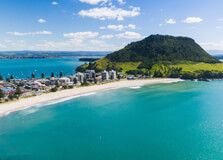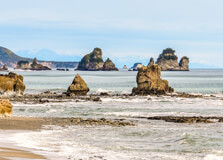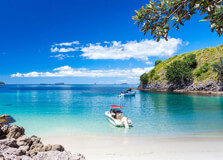
- Home
- Travel Packages
- Top Destination
-
Travel Attraction
By Category
Top Attraction

- Travel Agents
- Car Rentals
- Hotels

Papamoa Beach is a striking coastal gem in the Bay of Plenty, North Island, New Zealand. Stretching over 16 km between Mount Maunganui and the Kaituna River, it boasts broad, white sandy shores backed by dunes and pohutukawa trees, offering a relaxed, family-friendly vibe and stunning beach scenery :contentReference[oaicite:1]{index=1}. How to Reach Papamoa Beach, Bay Of Plenty By Car: A 15-minute drive east from Tauranga along the Te Tumu/NZ-2 highway leads directly to Papamoa Beach. Free street parking is available near Papamoa Domain adjacent to Tasman Holiday Park :contentReference[oaicite:2]{index=2}. By Bus: Local Bayhopper and school bus services connect Tauranga and Mount Maunganui with stops within easy walking distance of the beach. By Bike or Walking: The Te Awanui Trail cycleway runs through Papamoa, offering safe, scenic access from Mount Maunganui. It's also a pleasant walk from nearby suburbs :contentReference[oaicite:3]{index=3}. Weather at Papamoa Beach Papamoa has a temperate maritime climate with mild winters and warm summers. Average summer temperatures range from 24–28 °C, and winter temperatures range from 8–15 °C :contentReference[oaicite:4]{index=4}. Rainfall averages around 1,200 mm annually, peaking during winter, while sunny summer days are ideal for beach adventures :contentReference[oaicite:5]{index=5}. Bring sunscreen, hats, and layers to adapt to coastal breezes. Timings of Papamoa Beach As a public, open beach, Papamoa is accessible 24/7, year-round. Lifeguard patrols are seasonal, typically active during summer (November to March), ensuring swimming safety :contentReference[oaicite:6]{index=6}. Why Papamoa Beach is Famous Expansive white sand: A continuous 16 km stretch that rarely feels overcrowded, even in peak season :contentReference[oaicite:7]{index=7}. Scenic dunes & pohutukawa: Coastal flora and rolling dunes create a tranquil, natural atmosphere :contentReference[oaicite:8]{index=8}. Surf & swim-friendly: Big waves attract surfers, while calmer areas and lifeguards make it suitable for families :contentReference[oaicite:9]{index=9}. Cultural heritage: Named “Papamoa” (“fortified village”), it has Māori pā and hilltop pā sites, including Papamoa Hills Regional Park :contentReference[oaicite:10]{index=10}. Unique wildlife: Bronze whaler sharks frequent the shallows December–March, thrilling snorkelers and photographers :contentReference[oaicite:11]{index=11}. Entry and Visit Details There is no entry fee. Facilities include: Public toilets and changing areas at Papamoa Domain. Free roadside parking—arrive early in summer to secure a spot. Seasonal lifeguard patrols marked by red-and-yellow flags. Access to walking paths, cycle paths, and picnic areas. No swimming further from flagged areas due to undertows. History and Cultural Heritage Papamoa was first settled by Māori around 1400 CE. The name means “fortified village,” reflecting its strategic pā sites and fertile lands :contentReference[oaicite:12]{index=12}. Urban development began post-1988 after the Tauranga Harbour Bridge opened, connecting the area to Tauranga and Auckland :contentReference[oaicite:13]{index=13}. The Papamoa Hills Regional Park, established in 2003, contains archaeological sites and pā remains, with protected native vegetation and cultural trails co‑managed by local iwi :contentReference[oaicite:14]{index=14}. Things to Do at Papamoa Beach Surfing & swimming: Lessons and rentals available; swim between flags for safety :contentReference[oaicite:15]{index=15}. Beach walks: Long coastal strolls with views of Moturiki Island and Mount Maunganui. Fishing: Shore fishing for kahawai, snapper; boat trips from nearby marinas. Wildlife tours: Dolphin spotting, wildlife cruises and potential shark sightings :contentReference[oaicite:16]{index=16}. Culture & hiking: Guided walks in Papamoa Hills revealing Māori heritage :contentReference[oaicite:17]{index=17}. Cycling: Ride the scenic coastal trails via Te Awanui Pathway :contentReference[oaicite:18]{index=18}. Beach recreation: Volleyball, sunbathing, picnicking on sand or grassy dunes. Photography: Sunrise and sunset shots with reflections and dramatic skies :contentReference[oaicite:19]{index=19}. Interesting Facts Pāpāmoa Beach nudity is culturally accepted; unofficial clothing-optional zones exist :contentReference[oaicite:20]{index=20}. Bronze whaler sharks often swim knee-deep along the shore in warm months :contentReference[oaicite:21]{index=21}. Population surged after Harbour Bridge opened in 1988, transforming farmland into suburbs :contentReference[oaicite:22]{index=22}. Papamoa Plaza serves as the main shopping hub since 1997 :contentReference[oaicite:23]{index=23}. Pāpāmoa Hills Park protects more than 60 archaeological sites, plus thousands of planted native trees :contentReference[oaicite:24]{index=24}. Tips for Visiting Papamoa Beach Arrive early in summer for parking and peaceful sunrise views. Always swim between flags and respect lifeguard instructions. Wear sunscreen, sunglasses, a hat, and bring a windbreaker for breezy days :contentReference[oaicite:25]{index=25}. Bring a light rain jacket in winter—weather can shift quickly. If snorkeling, dive around Moturiki Island—rocky habitats harbor marine life. Don’t get spooked by sharks—bronze whalers rarely harm people but photo from safe distance is wise :contentReference[oaicite:26]{index=26}. Explore Papamoa Hills trail for cultural insight and panoramic vistas. Support local businesses—Papamoa Plaza, cafes, and food trucks enhance the beach experience. Join seasonal events like markets or cultural festivals at beach reserves.
Explore More
Punakaki Beach is located on the West Coast of New Zealand’s South Island, offering one of the most scenic and untouched coastal environments in the country. Known for its rugged beauty and dramatic landscapes, Punakaki Beach is a popular destination for nature lovers, photographers, and adventure seekers. The beach is part of the Paparoa National Park and is best known for its iconic Pancake Rocks, which are natural limestone formations that attract tourists from all over the world. How to Reach Punakaki Beach, West Coast Getting to Punakaki Beach is fairly straightforward, but it requires a bit of travel to reach this relatively remote area. The easiest way to get there is by car, as it is about a 45-minute drive north of Greymouth, a major town on the West Coast. From Greymouth, you can follow State Highway 6 north, and the turn-off to Punakaki is well-signposted. The drive offers spectacular views of the coastline and surrounding mountains, making it a journey worth taking in itself. If you're coming from further afield, the closest major cities are Christchurch (about 3 hours by car) and Nelson (about 4 hours by car). For those traveling without a car, buses run from Greymouth, but renting a car will give you the most flexibility to explore the area at your own pace. There are also some organized tours available from Greymouth that include stops at Punakaki Beach and other local attractions. Weather The weather at Punakaki Beach is typical of the West Coast of New Zealand, with mild temperatures and frequent rainfall throughout the year. Summer (December to February) brings warm temperatures ranging from 12°C to 20°C (54°F to 68°F), making it a great time for outdoor activities. However, the West Coast is known for its unpredictable weather, so visitors should always be prepared for rain, even during the summer months. Winter (June to August) is cooler, with temperatures ranging from 4°C to 12°C (39°F to 54°F). The beach and surrounding area can be quite dramatic during this time, with the waves crashing against the rocky coastline, creating an unforgettable sight. Visitors should be prepared for rain and strong winds, which are common during the winter months. It is advisable to pack waterproof clothing and sturdy footwear, especially if you're planning to explore the rugged trails in the area. Timing Punakaki Beach is open to visitors year-round, though the best time to visit is during the summer months (December to February) when the weather is warmer, and the beaches are more inviting. The spring and autumn months (September to November and March to May) are also excellent times to visit, as the weather is mild, and the area is less crowded. Winter, while still beautiful, brings colder and wetter conditions, so if you're looking to avoid the chill, it's better to visit during the warmer months. Why Famous for Punakaki Beach, West Coast? Punakaki Beach is famous for its spectacular Pancake Rocks and blowholes, which are some of the most striking natural formations on the West Coast. The Pancake Rocks are unique limestone formations that have been shaped over millions of years by erosion and weathering. The rocks are layered, giving them the appearance of a stack of pancakes, hence the name. The blowholes, located at the base of the rocks, are particularly impressive during high tide when water shoots through the cracks in the rocks, creating a dramatic display of natural power. The area surrounding Punakaki Beach is part of the Paparoa National Park, which is known for its diverse ecosystems, including rainforests, coastal cliffs, and wetlands. The park is a haven for wildlife, and visitors may encounter native bird species such as the kea, tui, and bellbird. Punakaki Beach offers a peaceful retreat away from the hustle and bustle of more tourist-heavy areas on the South Island, making it an ideal spot for nature lovers and outdoor enthusiasts. Entry and Visit Details about Punakaki Beach, West Coast Entry to Punakaki Beach itself is free, as it is part of the public land in the Paparoa National Park. Visitors can access the beach from the main viewing area near the Pancake Rocks, where there are walking tracks and viewpoints. The park is open year-round, and while there are no specific hours for visiting the beach itself, the nearby visitor center at the Pancake Rocks is typically open from 8:30 AM to 5:00 PM daily, offering information and guidance about the area. While the beach and the Pancake Rocks are free to visit, some activities, such as guided tours or specific walking tracks, may require a fee. The visitor center provides maps and details about the various trails and points of interest in the area. It’s a good idea to stop by the center to learn more about the natural history and geology of the area before embarking on your exploration. History and Architecture The history of Punakaki Beach is deeply tied to the natural forces that created the Pancake Rocks. The limestone formations were formed millions of years ago from the remains of marine creatures that settled on the ocean floor. Over time, the land was uplifted, and erosion shaped the rocks into the distinct layers that we see today. The blowholes are created when water from the sea is forced through narrow gaps in the rocks, creating spectacular geyser-like bursts of water. The area around Punakaki Beach was historically used by Māori as a source of food, particularly for gathering shellfish and fishing. The first European settlers arrived in the area in the 19th century, and the West Coast quickly became a center for gold mining. Today, the area is protected as part of the Paparoa National Park, ensuring that the natural beauty of the region is preserved for future generations. Things to Do in Punakaki Beach There are plenty of activities to enjoy around Punakaki Beach, whether you're an adventure seeker or someone looking to relax and take in the scenery. Some of the best things to do include: Visit Pancake Rocks and Blowholes: The main attraction at Punakaki Beach, the Pancake Rocks are an impressive sight. Visit during high tide to witness the blowholes in action as water shoots through the rocks. Explore the Walkways: There are several walking tracks in the area, including short walks to the Pancake Rocks and more extended hikes that take you through the surrounding rainforest and coastal areas. Photography: The rugged coastline, dramatic blowholes, and stunning sunsets make Punakaki Beach a photographer’s paradise. Capture the natural beauty of the beach, rocks, and wildlife. Wildlife Watching: The region is home to a variety of bird species, including the iconic kea and tui. Bring binoculars for birdwatching or a camera to capture the beautiful native wildlife. Beachcombing and Relaxation: If you’re in the mood to relax, Punakaki Beach is a great place to enjoy the peaceful surroundings, have a picnic, or simply unwind and listen to the sound of the waves. Facts about Punakaki Beach Punakaki Beach is located in the Paparoa National Park, which covers 3,200 hectares of stunning coastal scenery. The Pancake Rocks are composed of limestone, and their layered appearance is due to the slow process of compression and erosion over millions of years. The blowholes are most active during high tide, creating spectacular geyser-like bursts of water. The area is also a haven for native wildlife, with several bird species inhabiting the region, including the kea and the bellbird. Tips for Visiting Punakaki Beach Be prepared for unpredictable weather. The West Coast is known for its rain, so pack waterproof clothing and sturdy footwear for walking. Visit during high tide for the best view of the blowholes in action. If you're planning to walk the tracks, make sure to wear comfortable shoes, as some of the paths can be uneven or muddy. Bring a camera to capture the stunning scenery, especially at sunrise or sunset when the light creates beautiful effects over the rocks and coastline. Respect the natural environment and follow Leave No Trace principles while exploring the area.
Explore More
Whitianga Beach, located in the charming town of Whitianga on the Coromandel Peninsula, is a picturesque destination offering a blend of natural beauty and recreational activities. This east-facing beach stretches approximately 5 kilometers along Mercury Bay, providing ample space for relaxation and exploration. How to Reach Whitianga Beach, Whitianga Whitianga Beach is easily accessible from the town center, situated at the southern end of the beach. Visitors can reach the beach by walking, cycling, or driving from various accommodations and eateries in Whitianga. For those traveling from Auckland, Whitianga is approximately a 3-hour drive, covering a distance of about 191 kilometers via State Highway 25. Public transportation options include InterCity buses and Go Kiwi Shuttle services, which connect Whitianga to other parts of the Coromandel Peninsula and the North Island. Weather Whitianga enjoys a temperate maritime climate, characterized by mild winters and warm summers. Average summer temperatures range from 20°C to 25°C, while winter temperatures typically hover between 10°C and 15°C. The beach is a popular spot year-round, with summer months attracting more visitors for swimming and sunbathing. For the latest weather updates, it's advisable to check local forecasts before planning your visit. Timing Whitianga Beach is open to the public year-round, with no specific opening or closing hours. However, it's recommended to visit during daylight hours for safety and to fully enjoy the beach's amenities. The town center offers various services, including cafes and shops, which are typically open from early morning until late afternoon, providing convenient access to refreshments and supplies. Why Famous for Whitianga Beach, Whitianga? Whitianga Beach is renowned for its pristine white sands and clear blue waters, making it an ideal destination for beachgoers. The beach is popular for swimming, picnicking, and leisurely walks along the shoreline. Its location within Mercury Bay offers stunning views of the surrounding landscapes, including nearby islands and volcanic formations. The beach's accessibility and family-friendly environment contribute to its popularity among both locals and tourists. Entry and Visit Details about Whitianga Beach, Whitianga Access to Whitianga Beach is free, with no entry fees required. The beach is open to the public at all times, allowing visitors to enjoy its natural beauty and recreational opportunities. Facilities near the beach include public restrooms, picnic areas, and parking spaces. Visitors are encouraged to adhere to local regulations and maintain the cleanliness of the beach by disposing of waste responsibly. History & Architecture Whitianga Beach is situated in a region with a rich history. The town of Whitianga was historically a center for boat building, kauri milling, flax milling, gold mining, and gum digging. Over a period of sixty years, it is estimated that over 500 million feet of kauri timber was exported from the Whitianga district. The beach itself has witnessed the evolution of the town from a bustling port to a tranquil seaside destination. While the beach's natural landscape remains its primary attraction, the surrounding town center features a mix of historic and contemporary architecture, reflecting the area's development over time. Things to Do at Whitianga Beach Visitors to Whitianga Beach can engage in a variety of activities: Swimming and Sunbathing: Enjoy the warm waters and relax on the sandy shores. Fishing: The beach is a popular spot for surfcasting and pipi harvesting. Walking and Cycling: Explore the beach and surrounding areas on foot or by bike. Picnicking: Utilize the picnic areas to enjoy meals with scenic views. Photography: Capture the stunning landscapes and seascapes. For those interested in exploring further, nearby attractions include the Mercury Bay Museum, offering insights into the region's history, and the Whitianga Wharf, a hub for local maritime activities. Facts about Whitianga Beach, Whitianga The beach spans approximately 5 kilometers along Mercury Bay. It is an east-facing beach, offering beautiful sunrises over the Pacific Ocean. The beach is named after the Royal Navy ship Buffalo, which was wrecked during a storm while anchored in Mercury Bay. Buffalo Beach is a popular spot for swimming, fishing, and picnicking. The beach is located near the town center, providing easy access to various amenities and services. Tips for Visiting Whitianga Beach, Whitianga Sun Protection: Apply sunscreen and wear protective clothing, as the sun can be intense. Stay Hydrated: Bring water to stay hydrated, especially during warmer months. Respect Local Wildlife: Avoid disturbing marine life and seabirds in the area. Clean Up: Dispose of trash responsibly to maintain the beach's cleanliness. Check Tides: Be aware of tide times if planning activities like fishing or walking along the shoreline. Conclusion Whitianga Beach offers a serene and picturesque setting for visitors seeking relaxation and outdoor activities. Its natural beauty, combined with the town's rich history and accessible amenities, makes it a must-visit destination on the Coromandel Peninsula. Whether you're looking to swim, fish, or simply enjoy the coastal scenery, Whitianga Beach provides a welcoming environment for all.
Explore More